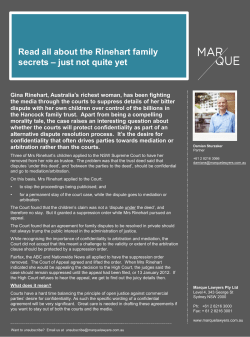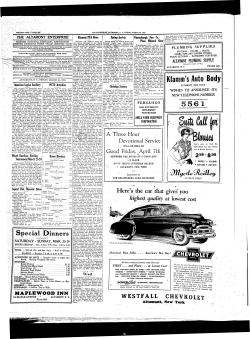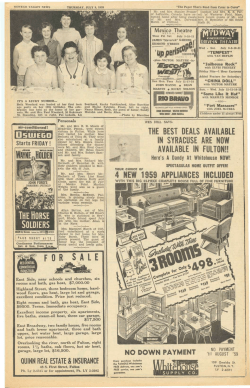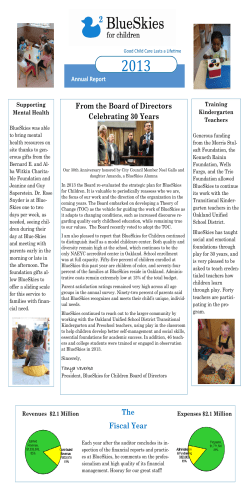
QUESTIONS FOR GINA RINEHART A. The Roy Hill Project:
QUESTIONS FOR GINA RINEHART ANSWERS ON BEHALF OF HANCOCK PROSPECTING PTY LTD A. The Roy Hill Project: 1. With the equity partners now in place for the project, how soon do you believe the finance will be in place? Hancock Prospecting Pty Ltd (“HPPL”) is working with its debt advisors towards securing the debt finance this year that is required to develop the Roy Hill project. Development has already commenced with the equity funds provided by HPPL and equity participants from Asia. Roy Hill, after exploration work, evaluation studies and early stage development, is now recognised as a major world class tier one project, and substantial interest in participating in the debt financing has been expressed by all major Australian banks, many international banks and various Export Credit Agencies. However conditions in Australia such as but not limited to its high cost and future additional impositions, such as the world’s highest carbon tax and MRRT, make the raising of such massive debt finance more difficult. 2. Do you believe you will achieve the publicly laid down timetable for the project? There are significant challenges for development projects in the Pilbara, including the availability of labour willing to work in the Pilbara, lack of contractor capacity, cost pressures, regulatory hurdles and other hurdles, in addition to the cyclonic conditions in the Pilbara. Roy Hill is in the process of building a capable team of professionals to deliver the project. The equity partners were due to be in place last year, however, the litigation in the New South Wales Supreme Court brought by one then later two more of Mrs Rinehart’s children as plaintiffs in September 2011, delayed equity finalisation. This in turn delayed the debt raising process and hence has delayed the Roy Hill project. 3. Do you still believe that you need a large number of workers from overseas under Enterprise Migration Agreements to get this project off the ground? Are the number of workers under EMA you require approximately 1,500? People in the media often do not appreciate that many Australians do not 1 want to work in the Pilbara, which is approximately 1,500km from Perth, away from their families, friends, doctors, dentists, pets, restaurants and city conveniences; especially when work in the Pilbara involves conditions that include dangerous cyclones, snakes as well as heat and the lack of city conveniences. It is a fact that over decades of experience, relatively few people have ventured from Eastern Australia to the Pilbara for work. The availability of tradesmen and skilled labour for large construction projects in remote areas like the Pilbara region of West Australia is very limited, particularly when we are faced with simultaneous competition for labour from other large development projects in the oil and gas and mining industries in Australia. Meanwhile the Australian unemployment rate has dropped to its lowest level for a year, and the WA unemployment rate is very low. At these levels, the labour required to build these large projects in the Pilbara, including Roy Hill, is simply not available either in WA or Australia. 4. There has been much media speculation that the Roy Hill project is particularly important to you as it will allow you to achieve your ambition of taking the lead in developing a major mining project as a majority owner, a vision your father had not been able to fulfil; is this speculation accurate? HPPL has a long and proud history of involvement in the Australian iron ore industry since the 1950s, and more recently in Australia’s coal industry. The group’s development of the Roy Hill project, originally obtained under the chairmanship of Mrs Rinehart in 1993, is the latest achievement in a progression from the securing and building of the group in the 1990s, through the Hope Downs transaction with Rio Tinto in 2005 after years of exploration and evaluation and completing feasibility and other development studies, plus the partnering with India’s GVK in the group’s Queensland coal projects, after HPPL had funded and achieved a bankable feasibility study, undertaken the first mining in the Galilee Basin and achieved the first export of coal from the Galilee Basin, helping to open this giant new coal basin. These milestones, pursued and achieved with a very small and hard-working executive team, provided the equity strength needed to commit to developing the company’s own Roy Hill project, together with our Asian partners. The CEO of POSCO recently mentioned that one of the factors that helped to build their relationship with HPPL was Mrs Rinehart’s desire to fulfil her father’s vision that HPPL would lead the development of a major iron ore mining project as a majority owner. 2 B. The Hope Downs mine: The flagship of the Hancock group of companies is, and has always been, Hancock Prospecting Pty Ltd (“HPPL”). HPPL was incorporated on 25 November 1955 by Langley George Hancock (“Mr Hancock”) to hold and develop all of the Hancock family’s exploration and mining prospects, interests and royalties; the royalties having been used over many decades to explore for iron ore, acquire tenements, pay for their rental, meet expenditure commitments of such tenements, study the tenements, seek approvals etc., and provide staffing for all of this. The Hope Downs tenements were originally discovered by HPPL and at all times have been beneficially owned by HPPL. Please refer to the attached letters regarding the re-acquiring of the Hope Downs tenements. HPPL’s dealings with government are consistent with that. The series of ABC’s questions that follow speculate on, or are based on largely irrelevant or superceded matters and fail to understand the fundamentals of HPPL’s ownership of Hope Downs. They also fail to understand the hopelessly insolvent position of HFMF and its inability to maintain or develop the tenements given its lack of money and hopelessly insolvent position. Further, the questioning fails to appreciate the funding and development of Hope Downs, and, related estoppel points and the Hope Downs Deed, of which the ABC has a copy, or access to it (e.g. clause 4). 1. In late 1992 you signed the state agreement with Carmen Lawrence’s Government for the development of the Hope Downs tenements. The corporate entity named in the agreement was Hope Downs Ltd, can you confirm whether that company was held ultimately at the time by the Hancock Family Memorial Foundation or Hancock Prospecting Pty Ltd? The Iron Ore (Hope Downs) Agreement was executed on 30 November 1992 between the Honourable Carmen Mary Lawrence, Premier of the State of Western Australia, acting for and on behalf of the State, and Hope Downs Limited. The Agreement was ratified by the State via the Iron Ore (Hope Downs) Agreement Act 1992, enacted on 11 December 1992. Hope Downs Limited was incorporated on 9 September 1992 and became a wholly owned subsidiary of Hancock Prospecting Pty Ltd (“HPPL”) on 27 November 1992, the correct owner of the tenements (please refer to letters). 2. That 1992 agreement was signed when Mr Brian Burke was working for Hancock Prospecting, did he advise you on this project? 3 Brian Burke was a loyal friend of Mr Hancock who employed him as a consultant. The relationship was primarily one between Mr Hancock and Mr Burke. It is not known what discussions were held in relation to the then hardly explored Hope Downs tenements. According to a press release sent to the ABC on 14 June 1991, Mr Burke’s consultancy was focussed upon, “projects involving Eastern Europe and the USSR.” (See attached press release.) Mrs Rinehart did meet Mr Burke at various times, including amongst approx. 600 other people at Mr Hancock’s wake in the gardens of her home back in March 1992. (Below incorporates questions 3-5, which have been edited for clarity.) Further research on Hope Downs with the WA Mines Department shows that key Hope Downs tenements were [were registered as] transferred from Hancock Resources Ltd to Hope Downs Ltd, a wholly owned subsidiary of Hancock Prospecting in March 1993. At the time Hancock Resources Ltd was, according to the publicly available Porteous case documents, under the control of Zameover and part of the Hancock Family Memorial Foundation. Under the Deed Mr Lang Hancock signed before his death, according to the Coroner’s report, Zameover passed in trust to his grandchildren with Mrs Rinehart as a trustee. The Hope Downs tenements were originally and beneficially owned by HPPL. It was not open to improperly divert these HPPL tenements away from HPPL for grossly inadequate consideration, to a hopelessly indebted Foundation, unable to fund, secure or develop the tenements, or indeed anywhere. Zamoever Pty Ltd was a $2 shelf company, created on 3 March 1989 and later artificially deployed above this hopelessly insolvent Foundation, HFMF, and therefore unable to assist HFMF. … The tenements that later became known as Hope Downs were originally discovered by HPPL, however they were resumed into a Ministerial Reserve by the then State Government under Charles Court in approximately 1973. Attempts to regain rights to the tenements were unsuccessful until 1984, when then Premier Brian Burke wrote to Mr Hancock advising that the government was prepared to hold the reserves for HPPL, given Mr Hancock’s and HPPL’s endeavours. Rights of access were granted to HPPL in 1985 by the Minister for Minerals and Energy, Mr David Parker. The Hope Downs tenements and other tenements (non keys) were always beneficially and properly owned by HPPL, and were funded by HPPL. There was a short period prior to Mr Hancock’s passing on 27 March 1992, wherein 4 tenements were transferred improperly for grossly inadequate consideration, and against the interest of HPPL’s shareholders, however these were at all times still beneficially owned by HPPL. It was clear from legal advice later received that these transfers were improper and void. The earlier improper transfers had to be, given the improper transfers and HFMF’s hopeless insolvency, rectified. Due to the parlous state of affairs of the HPPL group upon the death of Mr Hancock on 27 March 1992, including large contingent liabilities that later became real liabilities that needed to be paid, the restructuring of the various entities in the family company group eventually became necessary for its ultimate security and survival. The final debt restructuring was also tax efficient. 5. At the time this debt restructure was carried out did you, as trustee for the children who had an interest in Zameover which controlled the Hancock Family Memorial Foundation, seek independent legal advice on their behalf in order to protect their interests in the debt restructure? If not why not? The genesis of the debt restructuring was the disastrous business activities undertaken in the late 1980s prior to Mr Hancock’s death on 27 March 1992 and prior to Mrs Rinehart’s chairmanship, that involved attempts to develop the McCameys iron ore deposit and the negotiation of barter trade contracts with Romania, controlled at the time by the communist dictator Ceausescu, and expensive shipping contracts. These activities resulted in substantial losses and, ultimately, liabilities that needed to be funded by loans arranged by HPPL prior to and after Mr Hancock’s death. Because HFMF was hopelessly insolvent, it agreed with its largest creditor (being HPPL) to restructure its debt. Had this not been done, it was highly likely that due to various commercial arrangements that were in place at the time, that some shares in the family company HPPL would end up under the control of non-family members. Further the arrangements wherein HPPL was the only company providing funding, yet not able to then deduct expenditure, made the then structure inefficient, to the detriment of HPPL shareholders. The restructuring was also necessary for the securing and funding of the tenements, tenements originally held and beneficially held by HPPL, the development of these tenements being in the interests of its shareholders. The debt restructuring was therefore in the interests of all the shareholders of 5 HPPL, being Mrs Rinehart and by way of the Hope Margaret Hancock Trust, her children. Independent legal advice was sought and obtained in relation to the necessary debt restructuring. 6. Did the amended trust deed of 1995 of the Hope Margaret Hancock Trust, as released by the NSW Supreme Court in March, void the need to seek independent legal advice on behalf of the children? HPPL does not comment on any matters in relation to the Hope Margaret Hancock Trust, given that it is currently the subject of litigation between Mrs Rinehart and Ginia Rinehart on the one hand, and some of Mrs Rinehart’s children on the other hand. 7. Has this issue (point 6 above) been a matter of legal dispute between you and your children in the past? No, not to HPPL’s knowledge. 8. Was the purpose of the Hope Downs Deed (released by the NSW Supreme Court) to share the profits of Hope Downs with your children? There were several purposes of the Hope Downs Deed and like many deeds, any benefits therein are subject to obligations on the part of the parties to such deeds not being breached. Since the Confidential Deed has been released by the NSW Supreme Court, the purpose of the Deed will be self-evident from its provisions. 9. Did your children receive independent legal advice as trust beneficiaries before signing the Hope Downs deed? It has already been before the court last year that Mrs Rinehart’s daughters all engaged an independent lawyer, who took contemporaneous notes and records. In relation to the Hope Downs Deed, it is also public knowledge that all the children were adults at the time that the Deed was executed in 2006 (and reexecuted in 2007). The provision of any non-public information by any party to that Deed in relation to commercial transactions under the Deed would represent a breach of the Deed. HPPL has no intention to breach the Deed. 6 10. Under the arrangements to share the profits from Hope Downs as of January this year have you distributed any profits to the children? The arrangements under the Hope Downs Deed are confidential as between the parties to that Deed. The provision of any non-public information by any party to that Deed in relation to commercial transactions under the Deed would represent a breach of the Deed. 11. On July 1, 2005, the Hope Downs joint venture agreement with Rio Tinto was signed just as the Hope Downs state agreement with the WA Government was due to expire; did the WA State Government exert any deadline pressure on you at the time to go into the joint venture with Rio Tinto? The expiry date of the State Agreement was the pressure to settle upon a joint venture partner. But there was no pressure to choose Rio or any other particular partner. The development timelines for Hope Downs had been extended several times, due largely to the changing priorities of HPPL’s joint venture partners (firstly Iscor, which unbundled to become Kumba, which was then taken over by Anglo American). Anglo American were obligated to the South African government to concentrate their resources and developments on local projects in Africa, ahead of projects in Australia. As a result of these activities in Africa, HPPL’s development timetable was significantly delayed, which in turn raised concerns within the WA Government, who wanted to see the development timely proceed. When the WA Government made it clear that further extensions beyond 30 June 2005 may not be granted, HPPL needed, after the determination of an arbitration, to buy out its partners. Rio Tinto eventually made a compelling offer to become a 50% joint venturer just prior to the deadline, and together HPPL and Rio Tinto have developed two very successful mines and are currently constructing a third mine, employing many Australians in the process, and contributing royalties and other taxes to the State. C. The inquest into Mr Lang Hancock’s death 1. Do you regret the large payments made to several key witnesses who provided evidence at the inquest after it was revealed in the inquest that a large amount of the money paid came from Hancock Prospecting? 7 This question is also wrongly based. The payment you refer to was under the direction of a consultant who in turn provided to another third party, who was not a witness in relation to the death of Mr Hancock, who was tasked with providing protection for very frightened witnesses, not tasked with giving money to witnesses. Only very small amounts were paid for witness expenses whilst being interviewed by lawyers or counsel, taxis, accommodation etc., as is normal practice for witnesses involved in legal proceedings. This was confirmed by extensive review after the Inquest. “Key witnesses” were not permitted to give evidence (such as Sir Joh BjelkePetersen and Therese Stroud whose statements are attached)* or the policeman who tested positively for narcotics while on the premises. One of the nurses, also a key witness, who attended Mr Hancock could not apparently be located. D. The Current Trust Action in the NSW Supreme Court 1. Are you disappointed that three of your children have sought to use the courts to bring an action to remove you as trustee of the Hope Margaret Hancock Trust? 2. Do you hope this matter will be settled soon? 3. Are you still concerned that the potential tax impact of vesting the trust could bankrupt your children? Mrs Rinehart is not able to comment on actions before the Court. The Court actions have been grossly misreported, examples of repeated incorrect themes are mentioned in the attached media releases* from Corrs Chambers Westgarth dated 9 March 2012 and 10 May 2012. It is available in the public domain that the Trustee has vested the Trust, so the shares are available for the beneficiaries when they so request, however to date they have chosen not to request their shares. E. The Federal Government’s Mining Tax 1. You have been personally the subject of political attack by the Treasurer Wayne Swan over your opposition to this tax. With negotiations still underway with the government to amend it, are you still lobbying to get this tax dropped altogether? 8 Mrs Rinehart’s views and the reasons why Australia is risking becoming uncompetitive and should not risk the imposition of higher costs on the mining industry need to be better understood by the media and those representing Australia’s interests. Her views have recently been supported by the published views of Rio Tinto and BHPB senior executives, Tom Albanese and Jac Nasser. The MCA, BCA and the World Economic Forum, have also recently been reporting studies in this regard, all showing Australia is a very high cost country for business and is worsening and risking its cost competitive position. 2. You donated a significant sum, $750,000, to AMEC before the last election to lobby against this tax; do you believe the lobbying campaign had any impact on the Gillard government? Mrs Rinehart does not believe that the lobbying campaign had any impact on the Gillard government. HPPL is a member of AMEC and has been for a long time. HPPL did make a donation to AMEC but the timing was only a few days before a deal was made with multinationals for the MRRT, so it is most unlikely that HPPL’s donation to AMEC had any impact on the MRRT, especially as there was almost no time to utilise most of the donation. F. The Climate Change Debate 1. You have clear views on the climate change debate and have helped to fund speaking tours by prominent figures like Professor Ian Plimer who is critical of much of the current climate science coming out of the universities. Can you indicate how much you donate to organisations and individuals that are challenging the mainstream climate scientists? 2. Did you donate to political and community organisations lobbying to block the introduction of the carbon tax last year? Mrs Rinehart remains concerned that imposing the world’s highest carbon tax will impact Australians negatively. Imposing such a high carbon tax will add to Australia’s high costs, not only for businesses already facing problems with cost competitiveness, but also for Australians. She remains concerned by the lack of understanding in the media on this issue. To lessen the fear the media have caused over these issues, Mrs Rinehart suggests that the media should also permit to be published that climate change has been occurring naturally since the earth began, not just the views of the climate extremists. It is a fact that there have been ice ages, then periods of global warming to end the ice ages, 9 for thousands of years, and these have occurred naturally, including due to the earth’s orbit, and not due to mankind at all. Mrs Rinehart points out that some people received notoriety claiming only a few decades ago that the earth was about to enter an ice age and understands some of those same people are now claiming, global warming instead. Mrs Rinehart admires people like Ian Plimer who have independently chosen on their own accord to stand up against this tidal wave, which has caused fear, and despite substantial attacks by some of the media and extremists for so doing. It is noted Professor Plimer had his own views on climate change long before he knew Mrs Rinehart and had given many such informative speaking tours prior to meeting Mrs Rinehart. G. The Media 1. There has been much speculation in the media about your role in hiring Andrew Bolt after you bought into Channel 10. Did you ask Lachlan Murdoch and or James Packer to hire Mr Bolt? If so, why? Andrew Bolt has a short programme on Channel 10 on Sundays. It is noted that his programme is very popular in country areas, yet unfortunately many country areas are unable to receive Channel 10. As stated previously by Mrs Rinehart, Mrs Rinehart hopes that should Mr Bolt’s time permit, that he would consider longer programmes on Channel 10. 2. You have currently acquired a significant amount of shares in Fairfax Media, what do you hope to achieve with this investment? Do you believe the size of your shareholding should entitle you to one or two positions on the Fairfax board in the near future? Fairfax’s largest three mast heads have been declining in circulation for five years, a long time. Fairfax’s share price has also declined significantly, some approximately 90%. HPPL had hoped that Mrs Rinehart may be viewed by the Board as a successful business person and a necessary “white knight” with mutual interest in a sustainable Fairfax, however unless director positions are offered without unsuitable conditions, Mrs Rinehart is unable to assist Fairfax at this time. HPPL may hence sell its interest, and may consider repurchasing at some other time. 10 3. Did you consider that your pursuit of a subpoena against the West Australian newspaper and its reporter Steve Pennells over his reports on the litigation in NSW would cause concerns for reporters and news editors at Fairfax and Channel 10? Some media has run with such suggestions, however it is important to note that the newspaper concerned with the subpoena had already repeatedly published the name of its source, so this is not an attempt to get a journalist to reveal their sacred source, despite some media’s incorrect suggestions. 4. You have a reputation for aggressively pursuing litigation in actions over the last two decades, do you believe that reputation is fair? HPPL has had attacks from third parties on its few remaining assets after Mr Hancock’s chairmanship by people wanting ownership or benefits from such HPPL assets, e.g. Hope Downs (repeatedly, different parties), Rhodes Ridge, and regarding a small part of Kevin’s Corner. HPPL has been forced to defend these attacks in the courts, and will continue to do so. HPPL has had a very difficult journey, but under Mrs Rinehart’s chairmanship has increased shareholder value very substantially, whilst at the same time having to spend time defending attacks by others in the courts. * Hancock Prospecting Pty Ltd requested that these attachments not be posted online. End 11
© Copyright 2026












